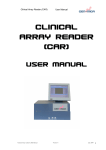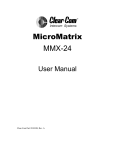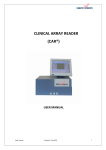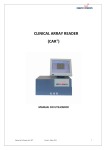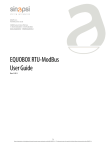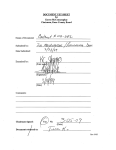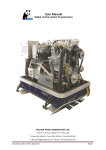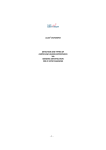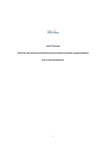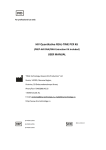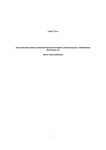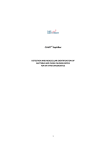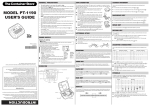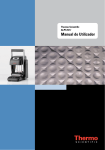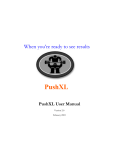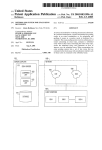Download Manual CAR V5 Feb11
Transcript
Clinical Array Reader (CAR) (CAR User Manual CLINICAL ARRAY READER (CAR) USER MANUAL Clinical Array reader (CAR) Manual Version 5-April 2011 1 Clinical Array Reader (CAR) (CAR User Manual 1. TABLE OF CONTENTS 1. Table of contents 1 2. Introduction 4 3. Components Description escription and Specifications 5 4. Installation 7 4.1 Precautions 4.2 Unlock/lLock for shipments 4.3 Assembling Screen 4.4 Connecting screen and reader 5. Safety Notes 11 6. Procedural Limitations 11 7. Switching on/off 12 8. Performing Strips (ASs) 8.1 Setting Samples Number 14 8.2 Setting Assay IDs 17 8.3 Setting Sample IDs 18 8.4 Working List 20 8.5 Reading 20 8.6 Summaryy Report and Results 22 8.7 Sample Reanalysis Reanaly 25 9 Performing ATs 10. 9.1 Placing ATs on the Adaptor 28 9.2 Changing Rack Type 29 9.3 Setting Samples Number 30 9.4 Setting Assay IDs 31 9.5 Setting Sample IDs 32 9.6 Working List 34 9.7 Reading Process 34 9.8 Summary Report and Results 36 9.9 Sample Reanalysis 38 Main Menu Options 10.1 Archive 42 10.2 Service 43 10.2.1 Import 44 10.2.2 System 44 Clinical Array reader (CAR) Manual Version 5-April 2011 2 Clinical Array Reader (CAR) (CAR User Manual 10.2.3 Backup/Backup /Backup Path 45 10.2.4 Settings 49 11. FAQ 11.1 .1 Updating software 50 11.2 .2 Exporting results – Backup path 53 11.3 Barcode rcode Reader: Characteristics and Installation 56 11.4 Metal frame ame for CLART® CLART Strips 56 Appendix 1- Abbreviations Used 57 Appendix 2 - Symbols and Warning Signs 57 Clinical Array reader (CAR) Manual Version 5-April 2011 3 Clinical Array Reader (CAR) (CAR User Manual 2. INTRODUC TRODUCTION The Clinical Array Reader (CAR)) has been designed for a quick detection and analysis of ASs. This detection and analysis represent the second step of an CSs assay. The first step of a complete CSs assay also involves experimental procedures (sample preparation, DNA extraction, DNA amplification and target labelling, specific hybridisation and d visualization of the results). Visualization Experimental Procedures The detection and analysis of CSs by the CAR is always performed immediately after developing the specific precipitation staining pattern on the CSss. Developing of this pattern generates a dot micromatrix (microarray) on the t the bottom of the CSs. This micromatrix can be detected and analysed by the CAR.. The results obtained by the CAR are automatically shown on the touch screen and can be printed or exported to your LIMS or pen-drive drive by its USB connections. connection Sample preparation, DNA extraction and DNA amplification/labelling of targeted molecules Standard laboratory equipment Specific hybridisation: labelled sample incubation against arrays. Visualization: conjugation and precipitation of the staining. Colorimetric Detection Dete and Analysis. CAR (Clinical Array Reader) Clinical Array reader (CAR) Manual Version 5-April 2011 4 Clinical Array Reader (CAR) (CAR User Manual 3.. COMPONENTS DESCRIPTION Touch Screen Reader’ss Tray Tra Function gauge Performance: Resolution on the sample: sample 3 µm Camera pixel resolution:: 8.3 Mpixel Scan time for complete lete 96-well 96 plate: 2-3 minutes Dynamic Range: 8-bits, bits, 255 greyscale Mechanical: Dimensions Width Height Depth 44 cm 21 cm 34 cm Additional 10 cm space must be provided in front of the instrument for microplate loading, as well as an additional 10 cm space at the back for cables and ventilation. Weight (without tactile screen) 15 Kg Replacement fan filter 80x80mm NMB, Part No.: F80/MR Environmental: Environmental Conditions Operating Temperature Storage Temperature Relative Humidity (non(non condensing) 0 – 70 ºC -40 a + 85 ºC 10 – 75 % Clinical Array reader (CAR) Manual Version 5-April 2011 5 Clinical Array Reader (CAR) (CAR User Manual Electrical: Electrical Specifications Rated Power Fuse type and rating two fuses Voltage 150 W 5x20 mm, 250V 1.6A slowblow 110 – 230 V (AC) a 50/60 Hz Image storage format 8--bit BMP greyscale Results storage age format CSV spreadsheet Internal PC: Specifications Operating System Processor RAM Memory Hard Disk Connections Windows XP home edition Intel Pentium II 1.6 GHz ( o mayor) 1 GByte DDR-2 40 GByte VGA, RS-232 232 (mouse and keyboard), Serial100 Base-T Ethernet, 3x USB2 Touch screen: Characteristics Type Resolution Colours rs Connections 12.1” TFT LCD 800x600 264 K 12V, VGA, USB-B, Mechanical mount VESA 75 Max current for 12VDC tactile screen supply: 3 Amp. Clinical Array reader (CAR) Manual Version 5-April 2011 6 Clinical Array Reader (CAR) (CAR User Manual 4. INSTALATION Please, follow ollow the the indications described in this manual to set up the Clinical Array Reader (CAR). ( 4.1 PRECAUTIONS - Verify that the instrument does not present any obvious sign of damage. If any damage is found, please contact immediately to your local GENOMICA’s GENOMICA representative entative. - Prepare approximately 1 m3 free area in the lab for the installation of the CAR. Once unpacked, place your CAR in a standing position on the bench space you have just prepared. Relocation of your CAR is only recommended by lifting it, DO NEVER PUSH USH YOUR CAR. - Make sure that the CAR is placed on a stable and perfectly horizontal bench. - Before connecting it to the power supply, make sure that your power line voltage corresponds to the operating voltage of 110-230 230 V (AC) at 50/60 Hz. Hz - Do not installll the CAR in the influence area of a heat or intense light source. 4.2 UNLOCK/LOCK THE READER In order to avoid system damages during transport,, internal mobile components of the CAR are locked. In order to unlock the reader, remove the big screw on the rear side and on the right side. Readers contain two locking systems, one on the rear side and one in the right side. During transportations, ations, the the position of the tray holder is fixed by lock screws, screw in order to protect the mechanical al components. components Remove these screws before switching on the instrument for the first time and keep them for the posterior assembling of the screen. screen No special tools are required to remove both screws. Clinical Array reader (CAR) Manual Version 5-April 2011 7 Clinical Array Reader (CAR) (CAR User Manual Fig.1: Unlocking the CAR. Position of the locking screws. Place the white plastic cap attached in the hole left by the lock screw at the side of the CAR (Fig. 2) Fig. 2: Covering the side hole left by the screw.. Should you need to send your instrument, the lock screws screw must be screwed securely in their positions. Unscrewed readers are susceptible of further damages during transportation. To install the transport lock screws, screw please follow these short instructions: - Turn off the instrument and remove the main power connection. - Slowly slide the tray holder manually lly fully towards the rear wall and place the screw at the rear of the CAR. - Then slide the tray holder fully to the right and place the screw on the side. - Tight them securely. Clinical Array reader (CAR) Manual Version 5-April 2011 8 Clinical Array Reader (CAR) (CAR User Manual 4.3 ASSEMBLING THE SCREEN Touch screen is provided separately. separat In order to connect it,, please follow these the indications: 1. Unscrew partially the two lower screws (yellow), and totally those marked in red, red all of them are placed place on the rear side of the reader. 2. Lean the screen over the reader fitting the screws with the positions marked in yellow. Insert the safety lock screws recently removed (green circles, below) in the positions marked in red (See below). 3. Once installed, screen’s arm should appears as follow: Clinical Array reader (CAR) Manual Version 5-April 2011 9 Clinical Array Reader (CAR) (CAR User Manual 4.4 CONNECTING SCREEN AND READER 2 1a, 1b, 1c Clinical Array reader (CAR) Manual Version 5-April 2011 10 Clinical Array Reader (CAR) (CAR User Manual 1. Connecting cables: 1a) a) Connect the power supply (Type Jack 3.5) 1b) Connect the USB p to one port at the right side. 1c) Connect ect the VGA connection to the blue connector. 2.. Switch on the screen by pressing the button on top. top 3. Switch on the CAR 5. SAFETY NOTES Please, be particularly aware of electrical hazards. Standard electrical safety precautions must be applied at all times. Only qualified personnel are permitted to perform electrical servicing. - Never touch switchers or outlets with wet hands. - Always switch off the instrument before disconnecting the AC power cord. cleaning major liquid spills and prior to - Always unplug the instrument prior to cleaning servicing the electrical or internal components. components - Do not open the housing of the instrument!. instrument! - Do not attempt any repairs or alterations except as expressly instructed in this manual or by the technical service.! - Avoid any movement or vibration during reading operation. 6. PROCEDURAL LIMITATIONS - Clinical Array Reader (CAR) has been designed for the detection and analysis of ASs/CSs (Array Strips/ trips/CLART® Strips) or ATs (Array Tubes®) only. Any other tubes, vials, or material aterial must not be used with this equipment. equipment - Only use Strips or Tubes processed in accordance to the AS/CS/AT protocols provided by GENOMICA. - Use of this equipment in a different way of that described in this manual will result in lost of your warranty warrant rights Please consider that the USB used for software updates or results export does not contain any antivirus.. GENOMICA is not responsible about viral infections and CAR cleaning will not be considered as a part of the technical support. Clinical Array reader (CAR) Manual Version 5-April 2011 11 Clinical Array Reader (CAR) (CAR User Manual 7. SWITCHING NG ON/OFF THE CAR 7.1 SWITCHING ON Check if your CAR requires a Dongle-key. Dongle (see FAQ 11.4). Depending on the CAR serial number, dongle-key key might be already installed inside or should be installed by user. A sticker on the rear side of the CAR will inform inform about the position of the dongle. Plug in the reader and switch it on. The main switcher is on the rear (right) side of the device. Once pressed, function gauge will display a yellow light. Press then the secondary switcher (Fig below), on the front side of the CAR and wait until function’s gauge turns green. Once your CAR is switched on the instrument will initialise, during this time the instrument will verify its good performance by a series of self tests. tests After finishing this set of self tests the th “Main Menu” screen (GENOMICA application) will appear on the touch screen.. screen Fig.: Secondary switcher at the front side 7.2 SWITCHING OFF First press “Shut Down” box on the main menu to switch off the CAR and then turn off the main switcher at the back side. It is important to shut down the CAR when not required, as this may lengthen its half-life half (Fig. 1). Do not switch off the reader directly since it could damage it!!! Clinical Array reader (CAR) Manual Version 5-April 2011 12 Clinical Array Reader (CAR) (CAR User Manual Shut down option at the GENOMICA’S main menu 8. READING STRIPS (AS/CSs) ( When performing CLART® CLART Strips make sure that the metallic frame required is properly positioned on the tray, as it is shown in the image below. In case of performing Array Strips, metallic frame is not necessary. Reading and analyzing samples is a sequential easy procedure, compose by multiple menus where user can choose among the several several options of the application. In order to start new analysis, analys choose option “New Analysis” on the th application’s main menu (Fig. 1). Clinical Array reader (CAR) Manual Version 5-April 2011 13 Clinical Array Reader (CAR) (CAR User Manual Fig.2: Main menu of the GENOMICA’s application Once this option is selected, a new menu will pop up on the screen, where 96 wells microplate sketch is depicted (Fig. 3). Fig. 3: 96 wells microplate sketch on the “New Analysis” menu. This menu (Fig. 3) represents the cornerstone of the application, since it allows the user to: - Set rack type: choose between 96 wells microtitter plate (AS/ AS/CS) or tubes adaptor (AT). Set the sample’s number to be processed. Set assay ID (HPV2 2, PneumoVir, ENTHERPEX,EnteroBac+...). Set sample ID (Sample Reference). Clinical Array reader (CAR) Manual Version 5-April 2011 14 Clinical Array Reader (CAR) (CAR User Manual 8.1 SETTING SAMPLE’S NUMBER The number of samples to be analyzed can be introduced manually or automatically, using a barcode reader. It’s not necessary to place the AS/CSs in correlative positions position for their analysis. Nevertheless, when the CAR is included in a Clinical Array Processor (CAP), AS/CSs must be placed in correlative order, at the left side of the frame. Automatic setting: For the automatic setting of sample’s number, user will need a bar-code code reader connected to the CAR (normal USB connection)(See connection) FAQ 2). GENOMICA can provide the user with specific bar codes for each assay upon request. a strips will Press “Set Assay IDs”” option, placed on the lower left side of the screen and all turn unselected on the “New New Analysis” Analys menu (Fig. 4). Fig.4: Left: Set Assay ID option on the lower left side of the screen. Right: All strips turn unselected when chosen this option Every barcode read, a strip is activated, automatically, on the microplate mi sketch and colour combination turnss from grey into a specific assay’s colour combination. combination (Fig.5) Clinical Array reader (CAR) Manual Version 5-April 2011 15 Clinical Array Reader (CAR) (CAR User Manual Fig. 5:: Specific colours combinations. combinations. Red: HPV, Blue: Pneumovir, Green: Entherpex. Manual setting: Software’s default settings, establish esta the e analysis of the whole microplate, microplate composed by up to 12 strips. Every strip not included in the process, must be manually unselected by the user. To unselect them, proceed to press on the symbol, which will turn into in , indicating the “no selection” of the strip. The unselected strip appears on a light-grey light colour (Fig. 6). Fig. 6: Selection of AS number. Sample’s number should be, always, a whole multiple of eight, which is the number of wells included in each strip. 8.2 SETTING ASSAYS IDs The automatic setting of sample’s number, in the previous section, allows the user to skip this step. Setting Assays IDs Manually: Manual Software processes by default the CLART® HPV2 assay. To read or analyse any other GENOMICA’S CLART® Assay, press the button on on the “New Analysis” menu (Fig. (F 7a), placed under each strip. strip Option “Edit” activates tes a new window (Fig. 7b) that lets the user choose among those assays shown in the pull-down pull menu. User can apply same Assay ID to the whole plate from the Edit menu. Clinical Array reader (CAR) Manual Version 5-April 2011 16 Clinical Array Reader (CAR) (CAR User Manual F Fig.7a: Selecting “Edit” option on the “New Analysis” menu. Fig. 7b: b: Manual setting of Assays IDs. A pull down menu shows the multiple choices to choose among Press “OK” when finish, to return to previous menu and follow up with the visualization vis process. Once assigned the assays’ IDs, strips will turn to the different colour combination specific spe for each type of analysis (Fig. 7C) Clinical Array reader (CAR) Manual Version 5-April 2011 17 Clinical Array Reader (CAR) (CAR User Manual Fig.7c:: Diferent colours combinations corresponding to different assays. 8.3 SETTING SAMPLES SAM IDs In the same way that in previous sections, setting samples IDs can be carried carr out, automatically or manually. In case of no Samples IDs assigment, software will set automatically a correlative number to each sample, from 1 to 96, starting arting with the sample sam placed in position 1A (upper-left). (upper Setting Samples IDs Automatically Barcode reader is required to to set Samples IDs automatically and barcodes must be set and printed before start setting the IDs. Set and print barcodes before starting. Press “Set Samples IDs” option and read the previously assigned barcodes barc normally. The software associates automatically a barcode to a sample position. Samples with already assigned ID will appear in black (Fig. 8) Clinical Array reader (CAR) Manual Version 5-April 2011 18 Clinical Array Reader (CAR) (CAR User Manual Fig 8: Setting Samples ID automatically. Once finished importing IDs, IDs press “Stop Import” to return to the “New Analysis” Analys menu. Setting Samples IDs Manually Select each position individually by pressing twice on it.. A new window representing a “tactile key board” will pop up on the screen (Fig. 9). Use it to set samples ID manually. Firstly, erase the number assigned automatically by the reader using the “Backspace” key, key then insert the ID desired. Fig 9: Setting “Samples IDs” manually, using the tactile e keyboard. keyboard The user can check the sample position at any time, since it appears at the upper-left upper side of the screen. Once finished with samples’ identification process, press “OK” to go back to the “New Analysis” menu (Fig.2). Clinical Array reader (CAR) Manual Version 5-April 2011 19 Clinical Array Reader (CAR) (CAR User Manual Then press “NEXT”. 8.4 WORKING LIST The working list allows the user to check, whether the already introduced information (samples references, assays...) is correct or not. To change any data, just press “Back” “ and repeat the setting process again (see “Set Samples IDs Manually” and “Set Assays ID Manually"). If all information is correct, press “Start” to carry on with the reading process (Fig. 10). Fig. 10: Working list, prior to analyzing. The working list includes necessary information for the samples’ traceability traceabilit (references, assay ID, position on the microplate...). 8.5 READING PROCESS/ PROCESS TAKING IMAGES Reader’s tray opening and closing processes are automatic. Do not try to force or move it manually. If neccessary, press the emergency button placed on the rear side of the CAR. CAR User will be requested to initialize the process (Fig. 11), ), by pressing the “Open Tray” box. Clinical Array reader (CAR) Manual Version 5-April 2011 20 Clinical Array Reader (CAR) (CAR User Manual Fig.11: Message to initialize the reading process. Once finished the opening process, place the microplate manually in the tray and operate the “Close Tray” box. (Fig.12). (Fig. Fig. 12: Message to activate the closing process of reader’s tray. Reading procedure can be monitored in the screen since samples/wells mples/wells change their colour indicating the reading status (Fig.13): - Wells in green:: Sample already analysed. Grid alignment agreed. - Wells in red: Sample may be reanalyzed. Grid alignment al failed (see “Sample Reanalyze” section below). - Wells in yellow: Sample has not been analyzed yet. Clinical Array reader (CAR) Manual Version 5-April 2011 21 Clinical Array Reader (CAR) (CAR User Manual Fig.13: Monitoring the reading process in the t CAR’s screen. Different colours for different analysis status. Once finished the reading process, user will be requested again to initialize the opening and closing procedures. (Figs. 12 and 13). Results will be shown once the microplate has been removed removed from reader and tray is closed. 8.6 SUMMARY REPORT AND RESULTS SUMMARY REPORT The CAR generates a final report including following information: - Date and time Position of the sample Assay ID Sample ID Results for each sample User can look up the he final report by selecting “Report View” option. It’s possible to print out this run report in PDF format, just by pressing the print option on the upper right side of the screen (Fig. 14). Clinical Array reader (CAR) Manual Version 5-April 2011 22 Clinical Array Reader (CAR) (CAR User Manual Fig. 14: Summary report created by the CAR at the end of the analyzing process.. process. RESULTS To visualize a specific sample’s result, select the sample/position on the microplate sketch (Fig.15) by pressing twice on it. it A new menu, showing working list and results, will appear on the screen (Fig. 16). ). On this menu, following options are shown: Export: To export reports and results to an external server, LIMS or USB. Print: If an external printer is connected via USB port, the selected result’s result page or all results data pages, including test image, can be printed by operating the "Print" button (See FAQ) Image: To visualize the image obtained by the CAR (Fig.18). Raw Data: To consult raw and normalized numerical values obtained in the analysis of the samples. Clinical Array reader (CAR) Manual Version 5-April 2011 23 Clinical Array Reader (CAR) (CAR User Manual Fig.16: Results menu By selecting the “Image Image” option, ption, user accesses to the image corresponding to the analyzed sample (Fig. 17 1 and 18). Fig.17:: Selecting “Image” option Clinical Array reader (CAR) Manual Fig. 18: Example of a HPV assay performed in strips Version 5-April 2011 24 Clinical Array Reader (CAR) (CAR User Manual By selecting “Raw Raw Data” option, option user accesses to the numerical values measured for each virus type (Fig. 19 1 and 20). Fig. 19:: Selecting “Raw Data” option Fig.20:: Raw data and normalized values 8.7 REANALYZING SAMPLES After the analysis process, red coloured c wells,, where the grid alignment has failed, can be reanalyze manually by user. In the e microplate sketch menu (Fig.15), (Fig.1 ), press on a red coloured sample/position sample/ to activate the reanalysis main menu window. window Browse the proper Assay among those from the the pull down menu (Fig.21) (Fig. and press “Start Reanalyze”. Fig.21: Main menu of the reanalyze option for ASs. By operating “Start Reanalyze” button, user accedes to the reanalysis sis application. The correct grid alignment consist in positioning the upper upper left marker over the upper left metal or biotin marker and then, adjusting the whole grid size by using the lower right metal or biotin marker. marker. Once the grid is squared properly, according to array’s dot micromatrix, press “Reanalyze” button (Fig. 22). Clinical Array reader (CAR) Manual Version 5-April 2011 25 Clinical Array Reader (CAR) (CAR User Manual In n order to place the upper left marker over its proper position, just press on it and drag it with the finger until both positions match. Once placed the first marker, user can open or close the grid size by dragging the lower right marker . Grid movementss are limited in order to prevent potential errors when aligning. Fig. 22: Placing metal markers according array’s matrix. Zoom tool, placed on the upper right corner of the screen, facilitates the reanalysis process.. Scroll the screen to visualize visuali upper and lower markers: Fig. 23: Manual grid alignment in strips, using metal markers, markers, and zoom tool. tool Once the markers are aligned, a press “Reanalyze” option (Fig 24) and an image with the grid will show the final alignment. If both, biotin and metal etal markers fits press “Accept” (lower- right side). If new adjustments are required, press “Retry” (Fig. 24) Clinical Array reader (CAR) Manual Version 5-April 2011 26 Clinical Array Reader (CAR) (CAR User Manual Fig. 24: Grid alignment checking Manual grid alignment implies user’s intervention in the results. If a manual grid alignment is required, required, an informative message will be shown in the run report. The image has been reanalyzed reanaly by user. reanalysis Fig.25: Informative message indicating the manual reanalysis. Clinical Array reader (CAR) Manual Version 5-April 2011 27 Clinical Array Reader (CAR) (CAR User Manual 9.. PERFORMING TUBES 9.1 .1 PLACING ARRAY TUBES ON THE TUBE ADAPTOR The ATs adaptor is provided by GENOMICA and allows the user to place up to 12 ATs for analyzing. For the adequate analysis of the tubes, is necessary to place them properly on the adaptor. Open the AT tube completely and turn back its cap. Hold the tube in this position and introduce both, tube and cap, at the same time into the adaptor as shown in Fig. 25. Tubes will be read in columns, like the ASs, starting from position A1, which is placed on the blunted square of the tube adaptor (upper left position). Fig. 25: Placing tubes in the adaptor. Select “New Analysis” option at the main menu of Genomica’s application (Fig. 26). Fig. 26: Selecting “New Analysis” at the main menu of GENOMICA’s application. Clinical Array reader (CAR) Manual Version 5-April 2011 28 Clinical Array Reader (CAR) (CAR User Manual 9.2 CHANGING RACK TYPE The software establishes the analysis an of a whole 96 well plate as default, composed by up to 12 strips.. In case of analyzing ATs (tubes), user should change the rack type. Select Rack” Rack on the top of the To change the rack type, just select the pull down menu “Select screen and choose “Tube be adaptor” adapt (Fig. 27) instead of “96 well plate”. Fig. 27: “Select rack” option at the upper left side of screen. A new window will pop up showing the tube adaptor sketch (Fig. 28).. Fig 28: Main menu when reading ATs. Clinical Array reader (CAR) Manual Version 5-April 2011 29 Clinical Array Reader (CAR) (CAR User Manual 9.3 .3 SETTING SAMPLE’S NUMBER NU The number of samples to be analysed can be introduced manually or automatically, by using a barcode reader. Automatic setting: For the automatic setting of sample’s number, user will need a bar-code code reader connected to the CAR (normal USB or PS/2 connection). Once the adaptor type is changed (see “Changing “ Rack Type” above) press “Set Assay IDs” option on the lower left side of the screen and all positions will turn unselected (Fig 29 and 30). Read as many barcodes as sample’s number you have and an tubes will turn to the specific assay’s colour combination (Fig. 31). Fig. 29 and 30: Setting Assay IDs automatically . Fig. 31: Different colours combinations for each array type Clinical Array reader (CAR) Manual Version 5-April 2011 30 Clinical Array Reader (CAR) (CAR User Manual Manual setting: In case of analyzing ATs, those tubes that are not going to be processed, should be unselected manually by pressing on indicated with (Fig. 32). symbol. The no selection of one tube will be symbol and the tube position will turn into a light/dark grey gre combination Fig.32: Selected positions appearing in assay’s specific combination. Unselected positions turned into light/dark grey combination. .4 SETTING ASSAYS IDs 9.4 The automatic setting of sample’s number, in the previous section, section, allows all the user to skip this step, because assays ID’s are already set. Setting Assays IDs Manually: Manually Software processes by default the CLART® HPV2 Assay.. To read or analyse any other GENOMICA’S CLART® Assay, select the position (by pressing on it) and then press “Edit Assay” option. Select the proper assay from those appearing in i the pull-down down menu as shown (Fig. (F 33) Clinical Array reader (CAR) Manual Version 5-April 2011 31 Clinical Array Reader (CAR) (CAR User Manual Fig.33: Multiple assays choices. Software gives also the possibility to select all tubes and edit the Assay ssay ID in all of them at same time. In case of processing all samples with same assay, user should select the “Assign Assay to all samples” on the Edit menu (Fig. 33). 3 9.5 SETTING SAMPLES IDs In the same way that in previous sections, setting Samples amples IDs can be carried carr out, automatically or manually. In case of no Samples IDs assigment, software will set automatically a correlative number to each sample, from 1 to 12, starting arting with the sample placed in position 1A (upper-left). (upper Setting Samples IDs Automatically Barcode reader is required to to set Samples IDs automatically and barcodes must be set and printed before start setting the IDs. Set and print barcodes. Press “Set Samples IDs” option and read the previously assigned barcodes barc normally. The software associates sociates automatically a barcode to a sample position. Samples with already assigned ID will appear in black (Fig. 34) Clinical Array reader (CAR) Manual Version 5-April 2011 32 Clinical Array Reader (CAR) (CAR User Manual Fig. 34: Setting Samples ID automatically. Once finished importing IDs, IDs press “Stop Import” to return to the “New New Analysis” Analys menu. Setting Samples IDs Manually Select each position individually by pressing twice on it.. A new window representing a “tactile key board” will pop up on the screen (Fig. 35). Use it to set samples ID manually. Fig 35: 35 Setting “Samples IDs” manually, using the tactile keyboard. keyboard The user can check the sample position at any time, since it appears at the upper-left upper side of the screen. Once finished with the samples’ identification process, press “OK” to go back to the “New Analysis” menu (Fig.29). ). Then press “NEXT”. Clinical Array reader (CAR) Manual Version 5-April 2011 33 Clinical Array Reader (CAR) (CAR User Manual 9.6 WORKING LIST The working list allows the user to check, whether the already introduced information (samples references, assays...) is correct or not. To change any data, just press “Back” “ and repeat the he setting process again (see “Set Samples IDs Manually” and “Set Assays ID Manually"). If all information is correct, press “Start” to carry on with the reading process (Fig. 36). Fig. 36: Workinglist when performing ATs 9.7 READING PROCESS Reader’s eader’s tray opening and closing processes are performed automatically. Do not try to force or move it manually. If neccessary, press the emergency button placed on the rear side of the CAR. User will be requested to initialize the process (Fig. 37), by pressing the “Open Tray” box. Clinical Array reader (CAR) Manual Version 5-April 2011 34 Clinical Array Reader (CAR) (CAR User Manual Fig. 37: Message to initialize the reading process. Once finished the opening process, place the tubes adaptor (ATs) manually in the tray and operate the “Close Tray” box. (Fig.38). (Fig. Fig. 38: Message to activate the closing process of reader’s tray. Reading procedure can be monitored in the screen since samples/wells amples/wells change their colours indicating the reading status stat (Fig. 39): - Wells in green:: Sample is already analyzed. analy Grid alignment succeded. - Wells in red: Sample may be reanalyzed. Grid alignment al failed (see “Sample Reanalyze” section below). - Wells in yellow: Sample has not been analyzed yet. Clinical Array reader (CAR) Manual Version 5-April 2011 35 Clinical Array Reader (CAR) (CAR User Manual Fig. 39: Reading process 9.8 SUMMARY REPORT AND RESULTS SUMMARY REPORT The CAR generates a final report including inc following information: - Date and time Position of the sample Assay ID Sample ID Results for each sample User can look up the final report by selecting “Report View” option.. From this menu, it is also possible to print it out in PDF format. (Fig. 40). Fig.40: Summary report created by the CAR at the end of the analyzing process. Clinical Array reader (CAR) Manual Version 5-April 2011 36 Clinical Array Reader (CAR) (CAR User Manual RESULTS To visualize a specific sample’s result, select the sample/position on the microplate sketch screen (Fig.15)) by pressing twice on it. A new menu, showing working rking list and results, will appear on the screen (Fig. 41). ). On this menu, following options are shown: Export:: To export reports and results to an external server, LIMS or USB. Print:: If an external printer is connected via USB port, the selected result’s result page or all results data pages, including test image, can be printed by operating the "Print" button (See FAQ) Image:: To visualize the image obtained by the CAR (Fig.18). (Fig.18 This image can be exported xported or printed individually with “print” option Raw Data:: To consult raw and normalized numerical values obtained in the analysis of the samples. Fig.41: Results menu By selecting the “Image Image”” option, user accesses to the image corresponding to the analyzed sample (Fig. 42 and 43) Clinical Array reader (CAR) Manual Version 5-April 2011 37 Clinical Array Reader (CAR) (CAR User Manual Fig.42:: Selecting “Image” option Fig. 43: Example of a HPV assay performed in strips By selecting “Raw Data” option, user accesses to the numerical values measured for each virus type (Fig. 44 and 45). Fig. 44: Selecting electing “Raw Data” option Fig.45:: Raw data and normalized values 9.9 SAMPLE REANALYSIS After the analysis process, red coloured wells,, where the grid alignment has failed, can be reanalyze manually by the user. In the e tube adaptor sketch menu (Fig.46), ), press on a red coloured sample/position sample/ to activate the reanalysis main menu window (Fig.47) (Fig. Clinical Array reader (CAR) Manual Version 5-April 2011 38 Clinical Array Reader (CAR) (CAR User Manual Fig. 46: 46 Grid alignment failed positions when performing Pneumovir Kit. When performing CLART HPV2 in tubes,, alignment must be carried out with wit the biotin markers instead of Metal Markers. Protocol rotocol stays the same The correct grid alignment consist in positioning the upper left marker over the upper left metal or biotin marker and then, adjusting the whole grid size by using the lower right metal tal or biotin marker. marker. Once the grid is squared properly, according to array’s dot micromatrix, press “Reanalyze” button (Fig 47 and 48). In order to place the upper left marker over its proper position, just press on it and drag it with the finger until both th positions match. Once placed the first marker, user can open or close the grid size by dragging the lower right marker. Grid movements are limited in order to prevent potential errors when aligning. Fig. 47: Manual grid alignment screen. Clinical Array reader (CAR) Manual Version 5-April 2011 39 Clinical Array Reader (CAR) (CAR User Manual F 48: Aligning the metal markers on the reanalysis menu. Fig. Zoom tool, placed on the upper right corner of the screen, facilitates the reanalysis to user (Fig. 49): Fig. 49: Manual grid alignment in strips, using metal markers, and zoom tool. Once the metal markers are aligned, press “Reanalyse” “ option (Fig.. 49) and a image with the grid will show the final alignment. If both, dots and metal markers, are well aligned, then press “Accept”” (lower(lower right side). If new adjustments are required, press “Retry” “ (Fig. 50) Clinical Array reader (CAR) Manual Version 5-April 2011 40 Clinical Array Reader (CAR) (CAR User Manual Fig. 50: Grid alignment checking Manual grid alignment implies user’s intervention in the results. If a manual grid alignment is required, an informative message will be shown in the run report. The image has been reanalysed by user. Fig.51: Informative message indicating the manual reanalysis. 10. MAIN MENU 10.1 ARCHIVE By operating the “Archive” option (Fig. 52), user accedes to a result’s search engine. Search must be enclosed between two dates, dates established by the user, use a starting date and an ending date (Fig. 53). ). Set the searching dates required and press “Next”. Fig. 52: “Archive” option on the main menu Clinical Array reader (CAR) Manual Fig. 53: Menu to set the searching period time. Version 5-April 2011 41 Clinical Array Reader (CAR) (CAR User Manual Search engine will find out all results contained between the two indicated dates. In order to specify the search, three extra searching parameters are available (Fig. 54) in the following menu: - Sample ID: Search samples with same code or ID analyzed ed during the specified time period. - Assay ID: Search samples amples processed with same procedure or assay during the specified time. - None: Search for allll samples included in the indicated time period. Fig. 54: Available searching parameters. 10.2 SERVICE By operating the “Service” button (Fig. 55)), user accedes to a submenu containing several reader’s options (Fig. 56): Fig.55: Selecting “Service” option from the Main Menu. Clinical Array reader (CAR) Manual Version 5-April 2011 42 Clinical Array Reader (CAR) (CAR User Manual . Fig. 56: Multiple options of the “Service” submenu. 10.2.1 IMPORT This option (Fig. 57) is mainly used for eventual updates in the software version (See section 11.1 for extended explanations). Fig. 57: Selecting “Import” option at the Service Menu. Clinical Array reader (CAR) Manual Version 5-April 2011 43 Clinical Array Reader (CAR) (CAR User Manual Fig. 58: Multiple importing sources. 10.2.2 SYSTEM System menu provides es the user with information regarding, software, hardware and CAR’s serial number (Fig. 59). Fig. 59: Selecting System option. Clinical Array reader (CAR) Manual Version 5-April 2011 44 Clinical Array Reader (CAR) (CAR User Manual Fig. 60: Information included in “System” menu. Press “Back” to return to the “Service” menu. 10.2.3 BACKUP// BACKUP BAC PATH Reader’s storage capacity is limited to 40 Gb, therefore “Backup” option represents a useful tool to save both, data (results, reports...) and CAR’s CA ’s settings. Moreover, CAR should not be considered as a database where results can be stored. In orderr to avoid undesirable data lost, backup should be perform regularly. regularly GENOMICA will not be responsible for the user’s data when the technical servicing is provided. Before saving results with the backup option, option, user must set the “Backup Path”. Path” SETTING BACKUP PATH Backup path sets up the target destination for the backup.. A remote folder or any other network drive can be specified.. specified. To set the backup path,, go to “Settings” option (Fig. 61): Clinical Array reader (CAR) Manual Version 5-April 2011 45 Clinical Array Reader (CAR) (CAR User Manual Fig. 62: Selecting “Settings” option at the “Service” menu Press “...” button: Fig. 63: “...” Box position Browse directories and external devices connected to the CAR and select the destination (Fig. 64). Press OK when finished. Fig. 64: Selecting directories or external devices. Clinical Array reader (CAR) Manual Version 5-April 2011 46 Clinical Array Reader (CAR) (CAR User Manual Once set the backup path, user can backup results by pressing the “Backup” button (Fig. 65): Fig. 65: Selecting “Backup” option. Next ext select “Results” (Fig. 66) on the touch screen and then “Next”. Fig. 66: Selecting “Results” backup. To speed up data backup, user user can introduce a time interval. All results/reports included between the starting date and ending date will be back up (Fig. 67). Then press “Next”. Clinical Array reader (CAR) Manual Version 5-April 2011 47 Clinical Array Reader (CAR) (CAR User Manual Fig.67: Introducing dates for the backup All selected runs are shown on an extra menu (Fig.68). Both options: “Backup only” or “Backup and Delete” are possible. User ser decides whether to keep data on the CAR’s reader or erase the already saved results. Fig. 68: List with selected results and the two backup options. Press “Next” to finalize the backup process. User can change the backup path at any time on the “Settings” menu (See FAQ). Clinical Array reader (CAR) Manual Version 5-April 2011 48 Clinical Array Reader (CAR) (CAR User Manual 10.2.4 SETTINGS “Settings” menu (Fig. 69) 69 allows the user to: - Adjust data/time manually. Insert both, data export and backup path. Set Language (only English, Spanish, French and Greek are available). Set default assay (Pneumovir, HPV2, HPV2 MM, ENTHERPEX) ENTHERPEX Fig. 69:Setting Default Assay Clinical Array reader (CAR) Manual Version 5-April 2011 49 Clinical Array Reader (CAR) (CAR User Manual 11. FAQ 11.1 SOFTWARE UPDATING GENOMICA will provide the software necessary to read eventual updates or changes in the kits. Please take care that the USB used does not contain any virus. virus GENOMICA is not responsible about virus infections and CAR cleaning will not be consider as a part of the technical support. Uncompress the zip file we have sent you on your yo pen-drive. Check that the pen-drive drive now contains one folder called ”patch” and one or more .bat files with the name of the kit that you want to install. It is important that all of them are in the main directory (e.g. D:\)) and not included inside any folder. fo Fig. 70 Connect your pen-drive drive to a free USB connection available on the back of the reader. Clinical Array reader (CAR) Manual Version 5-April 2011 50 Clinical Array Reader (CAR) (CAR User Manual Fig. 71: Go to the “Service” menu. Fig. 72: Selecting “Service” option. Press “Import” button. Clinical Array reader (CAR) Manual Version 5-April 2011 51 Clinical Array Reader (CAR) (CAR User Manual Fig. 73: In the dialog box you should shoul see both drives: C:\ and D:\(Corresponding (Corresponding to the USB stick). In some cases, it takes a couple of minutes to the reader to recognize the pen-drive. pen In those cases, go back to the principal menu and try again in a few seconds. Fig. 74: Browse the pen-drive drive contents by pressing on the plus symbol. You can see there the “patch” folder and the kits installation programs (in blue). Clinical Array reader (CAR) Manual Version 5-April 2011 52 Clinical Array Reader (CAR) (CAR User Manual Fig. 75 Select the kit that you want to install and press “Import”. Fig. 76 Installation will be finished when a new window pops up indicating that the process has been completed successfully. Please, close that window by pressing “Cross” button on the top right square. If the installation of more kits is required, repeat the process from step 4. Once finished, get back to the “Main Manu” and reinitialize the reader. In case that an error occurs during the installation process, please contact the technical service. Do not forget to attach the appearing error messages in your assistance request. Clinical Array reader (CAR) Manual Version 5-April 2011 53 Clinical Array Reader (CAR) (CAR User Manual Fig. 77 11.2 EXPORTING ORTING DATADATA EXPORT PATH User can select where to export all data. Results can be exported to a USB stick, an external rnal hard disk or to the LIMS just by selecting the proper export path. Steps for exporting results to an USB stick: Press “Service” option of the Genomica´s main menu: Fig. 78 Select “Settings” ttings” options on the secondary menu: menu Clinical Array reader (CAR) Manual Version 5-April 2011 54 Clinical Array Reader (CAR) (CAR User Manual Fig. 79 Browse directories by using the “...” option and select directory which corresponds to the USB stick.. Keep in mind that directory assigned to USB may be subjected to chages Fig. 80 Once selected the export path, all exporting data will be send using the export path. Data exporting should be performed from the “Archive” menu, following the next protocol: Select “Archive” option from fro the Main Menu: Clinical Array reader (CAR) Manual Version 5-April 2011 55 Clinical Array Reader (CAR) (CAR User Manual Fig. 81 Once selected this option, a searching engine will pop up. On this new window it’s possible to restrict the searching time period, inserting a start searching date and end searching date. Fig. 82 Search rch engine will find out all results contained between the two indicated dates. In order to specify the search, three extra searching parameters are available: - Sample ID: Search for samples with same code or ID analyzed during the specified time period.. - Assay ID: Search samples processed with same procedure or assay during the specified time. - None: Search all samples included in the indicated time period. Clinical Array reader (CAR) Manual Version 5-April 2011 56 Clinical Array Reader (CAR) (CAR User Manual Fig. 83 Press “Next” Next” to continue. 11.3 .3 BARCODE READER: CHARACTERISTICS AND INSTALLATION ON A simple barcode reader will be advisable since installation process is done automatically by the device just by connecting it at the rear PS/2 or USB port. PS/2 port Clinical Array reader (CAR) Manual Version 5-April 2011 57 Clinical Array Reader (CAR) (CAR User Manual Barcode Reader specifications specification (recommendation): Type Scanning Element Light Source Scanner Barcode Decode Capability Barcode Scanner CCD 660 nm red visible LED UPC-E, UPC-A, EAN-8, 8, EAN 13, JAN, UCC / EAN 128, ISBN, ISSN, Code 39, Code 93, Code 128, Interleave 2 of 5, MSI, Industrial 2 of 5, Matrix 2 of 5, IATA 2 of 5, China Post Code, Code 32, Codabar, ABC Codabar, CX Codabar, Code 11, UK Plessey, Telepen Scanning Speed 45 scans per second Decode Speed 100 scans per second Max Working Distance 1" Connectivity Interface PS/2 Power Requirements Voltage +5 VDC Operating Conditions Consumption Decoded: Standby <30 mA, Working <95 mA Temperature 0 to 50 Degrees C Humidity 20% to 80% non condensing 11.4 DONGLE. WHAT IT IS AND ITS USE Dongle is the name of an electronic key with USB appearance. Depending on the CAR’s serial number, Dongle can be found, whether the rear side of the CAR, attached with a bridle,, or internally (not visible) When the Dongle is placed outside, in the rear side, just insert the Dongle in a free USB port in order to let et the CAR work. Without the Dongle, Do gle, CAR will start a maximun of 30 times before stop working. When the Dongle is placed inside the CAR, it will be indicated in a sticker, at the rear side. Dongle works as a software license. In case of Dongle failure, GENOMICA application won’t be launch and CAR won’t be operative. Please, do not remove the Dongle from the CAR unless for shipping it to technical service. Dongle key Clinical Array reader (CAR) Manual Version 5-April 2011 58 Clinical Array Reader (CAR) (CAR User Manual 12. APPENDIX 1 ABBREVIATION IONS USED AS: Array Strips AT: Array Tube CAR:: Clinical Array Reader Fig. : Figure PCR: Polimerase Chain Reaction PDF:: Portable Document Format generate by Adobe. LIMS: Laboratory Information Management System CLART: Clinical Array Technology 13. APPENDIX 2 SYMBOLS AND WARNING SIGNS Yellow triangles indicate general warnings. Warnings include the risk injury to the user,, or serious equipment damage. This symbol indicates severe injury to the instrument operator due to interference of the user with moving parts of the CAR. This symbol indicates the risk of loss of life or severe injury to the user due to high voltage. This symbol indicates important information about the CAR and analyzing process. Please read these instructions carefully. This symbol indicates important information information regarding ATs analyse. Clinical Array reader (CAR) Manual Version 5-April 2011 59



























































